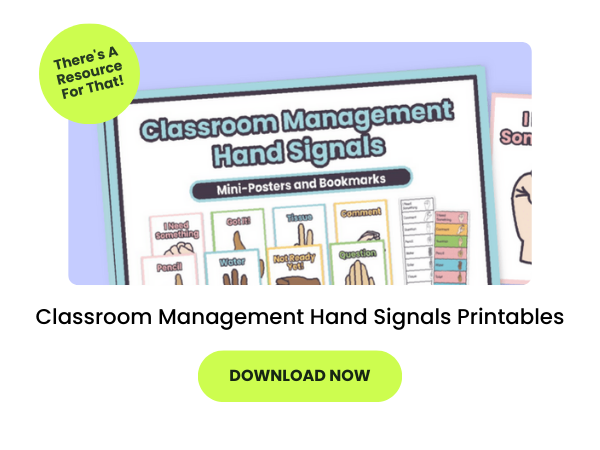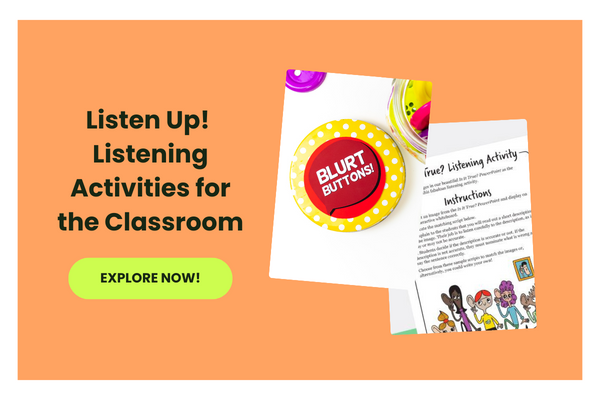Have you had one of those days when your students just couldn’t seem to follow instructions or listen closely to your directions? We have all had those days in the classroom, so you are far from alone.
The good news? There are some fairly simple tricks and tips you can employ to improve your students’ listening skills and get them following instructions to the letter.
The teachers on the Teach Starter team have compiled this simple list of instructions based on our own years in classrooms and experiences with kids with a broad range of listening skills. Read on for some tricks that might just help your classroom management!
How to Get Students to Follow Instructions
1. Use Visual Direction Cards
No matter the age, many of us can benefit from having visuals to help us remember directions. For kids in particular, visual reminders make it easier to tackle tasks more independently.
Print out a set of Visual Direction Cards, and stick a magnet to the back of each of the direction cards. This way they are ready to be stuck on the whiteboard board each time you give instructions. You can then write additional words beside the direction cards or number each direction for students to use as a visual reminder throughout the task as they follow the steps.
Print a set of visual behaviour expectation cards for the classroom!
2. Lower Your Voice
We know this may sound strange, but it’s quite common for teachers to increase the volume of their voice when they want students to listen. However, a loud voice is unpleasant and almost too easy to hear. This will often cause students to look away and get distracted by other things as they think they’ll hear the directions regardless — because you’re speaking so loud!
If you lower your voice, speaking just loud enough for the students to hear, you’ll find they instinctively stop moving around and lean in to listen. It also helps you remain calm when you feel like your classroom is just a little bit too loud and out of control.
3. Use a Magic Word
This is a great little hack for primary school students. Pick a silly word like ‘hot dog’ or ‘boondoggle.’ Tell the students they must not move or lift a finger until they hear you say the silly word.
For example:
- Say to the students, ‘When you hear our magic word, which is…?’
- Students respond with ‘Hot dog!’
- Continue on with your directions. ‘You’re going to need your English book, a sharp pencil and an eraser. Pop your hands on your head when you’re ready… HOT DOG!’
Students will often listen intently, waiting to hear the magic word. You can change the word every week and involve your class in picking a new magic word of the week. This gives them more ownership in the process as well.
4. Sing
Sing your directions to the kids! This works better for the younger year levels. It’s often best to pick a tune that both you and the students know, such as Old McDonald Had a Farm, and then sing the directions to that tune. There’s no need to get caught up in the musicality of it; the more ridiculous the song, the better!
There’s just something about singing that will alleviate stress or frustration, too. It helps both you and the students!
5. Use Nonverbal Hand Signals
Using nonverbal communication to help your students follow instructions is also a quick and easy addition to your instruction time in the classroom.
Here are some suggested signals:
- Ask students to show their understanding by a simple thumbs up or thumbs down.
- Have students ‘turn on’ their ears by twisting them. This signifies it’s important to listen at that exact time.
- As the teacher, you can pop your hands behind your ears and make eye contact with a student or a couple of students you feel aren’t 100% focused. This is a subtle way of keeping everyone on track when it’s time to listen to instructions.
6. Repeat to a Partner
You’ve probably heard from other teachers about the importance of students repeating the instructions back, but that doesn’t have to mean repeating something back to you. You can also have students repeat the steps to a partner. Give them several steps that they will need to repeat to the student sitting next to them.
This is also a great way for you to check in and ensure students have been able to remember the directions.
7. Act It Out!
Have students stand up and act out each of the directions. If, for example, one of the directions is to use the glue only in the corners of the worksheet rather than the whole page, have students act out just putting a ‘dot’ of glue on the worksheet.
8. Explicitly Teach Listening Skills
Listening skills don’t just develop naturally. While there is an element of age development when it comes to attention span, there’s also a need to explicitly teach students how to listen attentively and proceed with the information they have heard.
Setting aside class time early to support their listening skill development will make it easier for your students to follow directions in the long term.
9. Use ‘Wait Time’
After giving one direction, allow a short period of time (approx 3-7 seconds) to pass before you move on to the next instruction. Research into auditory processing in kids shows that young children process what they hear when they are given time for the information to sink in.
It’s such a simple concept, but sometimes we try to fill in the set explanation time with as much information as possible, as we’re worried we won’t have the students’ attention for long. Using ‘wait time’ actually makes more sense.
10. Be Precise in Your Instructions
Anyone who has ever opened up the instruction manual intended to be used when you put together a new piece of furniture knows how frustrating it can be to receive poorly worded instructions. The same is true for our students.
Your students may be trying to follow directions, but they’re simply confused because you have worded things poorly or overwhelmed them with too much information all at once. When assigning a task, choose your words carefully and be as precise as possible.
You may also find breaking the instructions into smaller, more manageable tasks will be easier for your students to digest. We also suggest numbering each step in lengthy directions to help students understand the correct order to proceed.
A Final Word on Following Instructions in the Classroom
You may find that a couple of these suggestions work well together. For example, you may use visual direction cards, a lower voice, and the magic word. It’s about adapting to suit the needs of the students in your class and a little bit of trial and error.









Just what I needed for the last week of the term!
Hey Natalie, it's always nice to get some new fresh ideas, isn't it? Best of luck for the last couple of days of the term.